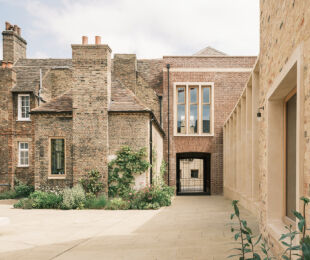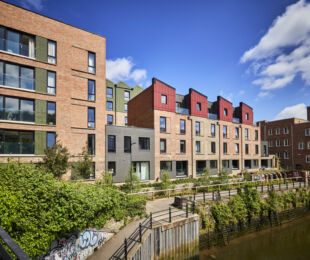
A unique eco-build children’s nursery in the village of Bellingdon, Buckinghamshire, nestled in an area of outstanding natural beauty amongst the Chiltern Hills. Designed by the world-renowned German architect Professor Gernot Minke, the octagonal building is constructed around a central earth dome.
The project was designed to make use of locally sourced natural materials from the Chilterns in order to create a sustainable, carbon-neutral, healthy building in which the children could thrive. To avoid the use of concrete on site, the foundations were filled with field flint that was sifted from the topsoil of the surrounding fields.
The centrepiece of the nursery is the stunning internal dome built using 'strocks', a natural building material developed by H.G.Matthews using nothing more than clay and straw. Strocks can be used for load bearing walls up to 3 storeys high, and when bedded in, with thin bed clay mortar, they create a homogenous earth wall. This provides a strong structure with the benefits of extremely low-embodied energy and 100% natural, healthy materials.
The bricks forming the octagonal outer walls are also from the same brick maker and are handmade wood fired bricks from the UK’s only clay brick manufacturer using wood to fire their kilns. Interestingly the technique was re-intoduced to the UK, from the USA, so as to produce the same subtle colour shades and glazes that characterised the beautiful bricks used in Britain during the 19th century and earlier.
Brick making can be an energy intensive industry, requiring large amounts of heat to dry the bricks and fire the kilns. As it is impossible to get away from this heat requirement, these bricks are made using renewable sources of energy, rather than standard fossil fuels.
The brickyard where they were made has installed an innovative system of biomass boilers which heat the brick drying sheds, as well as using wood to fire the kilns. The wood from the Chilterns is controlled by the Forestry Commission and provides a fully renewable, locally available source of energy, which is not only beautiful to look at but also provides a rich habitat while it is growing. The rooms surrounding the central dome of the nursery are plastered with clay mortar produced at the brickworks and are accessed through a series of archways created by the brickyard’s own Cutting & Bonding department. The arches were laid loose and provide a wonderful symmetry, leading the eye through the building and out towards the spacious gardens.
The internal and external brickwork has all been laid using pre-mix lime mortars and the walls are insulated with 'hempcrete' blocks made from hemp and lime, providing a natural source of insulation and regulating the indoor temperature throughout the year. If any extra heating is required, it is provided by an air source heat pump.
The roof structure, built using a system of glu-lam timbers, supports a green roof that has been seeded with wildflowers and will, in time, blend seamlessly into the local landscape.
Ceramics used for the tiles in the kitchen and bathrooms were all designed and produced by the same firm. The internal walls feature striking floor-to-ceiling mosaics demonstrating the symbiotic relationship between the elements, to enhance the children’s understanding of our closeness to nature. There are several beautiful sea creatures made up of pieces of glazed bricks and tiles from the brickyard, as well as recycled glass, and some genuine fossils which add to the tactile enjoyment of the building.
Karen Suckling, who runs The Village Nursery, describes it as a very calm building in which to work. There is a sense of peace that surrounds you as you walk around the building and a feeling of being nurtured by nature. Everyone involved is delighted with the way that the building has come together, proving that it is possible to create a unique building that is eco-friendly, healthy and sustainable, and will benefit the community for generations to come.






